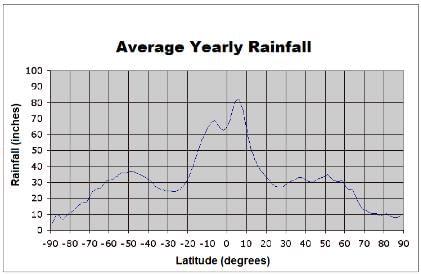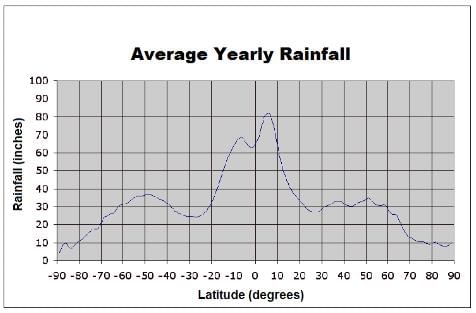Test: ACT Earth Sciences Data Representation Questions - ACT MCQ
10 Questions MCQ Test - Test: ACT Earth Sciences Data Representation Questions
The chart below depicts the average rainfall by location on the Earth. Zero degrees latitude corresponds to the equator. Positive latitudes are north of the equator, while negative latitudes are south of the equator. A latitude with a magnitude of 90 degrees correlates with one of Earth's poles.

Which best describes the rainfall trend between thirty and sixty degrees latitude?

The chart below depicts the average rainfall by location on the Earth. Zero degrees latitude corresponds to the equator. Positive latitudes are north of the equator, while negative latitudes are south of the equator. A latitude with a magnitude of 90 degrees correlates with one of Earth's poles.

The Tropic of Capricorn is about 23.5 degrees south of the equator. Approximately how many more inches of rain does this latitude experience than the North Pole?

A scientist has observed a new planet, Planet H. It was discovered that Planet H has water on its surface. As a result, it is being investigated to determine if it is possible for Planet H to sustain human life. Futhermore, observations revealed that Planet H has four moons: Moon J, Moon K, Moon L, and Moon M. Each moon's radius, distance to Planet H, and time to orbit Planet H have been recorded in the provided table.

On Earth the moon has a large effect on ocean tides. If it was found that the moons have a tidal affect on Planet H, then which of Planet H's moons would have the largest affect on its oceans?

Researchers have discovered a new planet, Planet Z. This planet is orbited by several comets, A, B, C and D. Researchers have calculated the time it takes each comet to orbit Planet Z, the closest the comet gets to Planet Z and the diameter of the comet.

What is the relationship between comet diameter and orbit time?
Researchers have discovered a new planet, Planet Z. This planet is orbited by several comets, A, B, C and D. Researchers have calculated the time it takes each comet to orbit Planet Z, the closest the comet gets to Planet Z and the diameter of the comet.

Another comet that orbits Planet Z was found and the comet has a diameter of 4.6km. Which of the following would be the best estimate of orbit time around Planet Z in Earth years?
Scientists have recorded data in Region A, Region B, Region C and Region D. The data collected include the average daily temperature, the annual rainfall for the past year and the number of fresh water reservoirs. The scientists want to perform an experiment on wild life migration patterns.

What is the relationship between average annual temperature and the number of fresh water reservoirs?
Scientists have recorded data in Region A, Region B, Region C and Region D. The data collected include the average daily temperature, the annual rainfall for the past year and the number of fresh water reservoirs. The scientists want to perform an experiment on wild life migration patterns.

If another region was found to have 20 fresh water reservoirs, what could be the amount of annual rainfall for that region in inches?
In a specific region, a scientist recorded the rainfall, in inches, during the months of May, June, July and August. The scientist recorded this data in the same spot each month over four years. The purpose of this study was to see how the new factories built in the area impacted the rainfall in that location.

How have the factories impacted the rainfall that was recorded each year?
In a specific region, a scientist recorded the rainfall, in inches, during the months of May, June, July and August. The scientist recorded this data in the same spot each month over four years. The purpose of this study was to see how the new factories built in the area impacted the rainfall in that location.

What trend can be noticed in the data?
Explorers have discovered a new planet, Planet K. It is known that Planet K has magnetic poles to similar to those of Earth, so the explorers decide that using a compass to navigate is possible. When navigating Planet K's surface, it is discovered that the compass points north for a distance then flips so that it points north in the opposite direction for a distance, before returning to pointing north in the original direction. It is known that the magnetic poles of the planet flip every 100 years. Weather is recorded on the planet for 250 years.

How does the flipping of the magnetic poles affect the weather on Planet K?



















